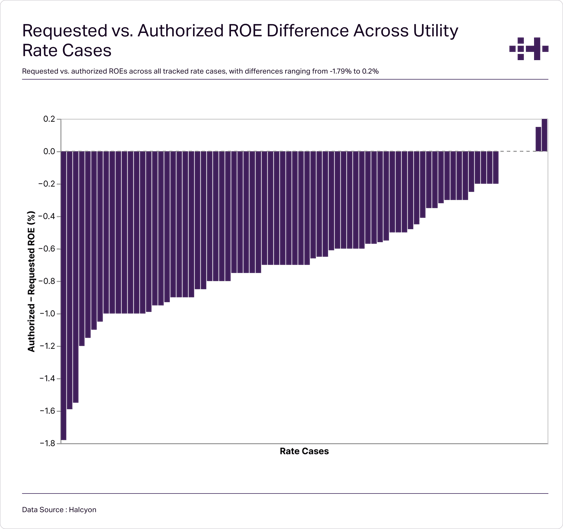Gain insight into trends in authorized and requested ROEs to better assess utility earnings potential.
How We Help Energy Professionals
INVESTORS
UTILITIES
Benchmark rate case filings against peer outcomes to strengthen regulatory positioning.
Law Firms
Leverage data to prepare arguments and monitor precedent in ROE decisions for utility clients.
Consultants
Identify emerging patterns in ROE methodologies and advise clients on rate case strategy.
Data Methodology
The Halcyon Rate Case Tracker follows rate case dockets filed with electricity commissions, focusing on return on equity. Using Halcyon’s AI search, our analysts researched rate cases from all Investor Owned Utilities (IOUs) in the PUCs they operate in. Dockets were then queried to extract the dataset, which was then reviewed by our subject matter experts.
Rate Case Data
(21 data points)|
Field |
Description |
| Docket | Identifier used by state Commission. |
| Halcyon Docket Profile Page | Halcyon AI generated Docket Profile Page. |
| Utility Name | The name of the investor-owned utility involved in the rate case. |
| Rate Case Years | The years covered by the rate case, indicating whether it represents a single-year or multi-year rate plan. |
| State | The state in which the rate case is filed and regulated. |
| EIA Utility ID | Utility ID used by EIA reporting sources. |
| BA Code | Relevant balancing authority. |
| Separate Cost of Capital Proceeding? | Indicates whether the return on equity (ROE) is determined in a separate cost of capital proceeding (Yes/No). |
| Cost of Capital Proceeding | A link to the separate proceeding in which the ROE is determined, if not included within the main rate case. |
| Date Opened | The filing date marking the start of the rate case proceeding. |
| Decision Date | The date the final order or decision was issued by the commission. |
| Final Order/Settlement Agreement 1 | A link to the document page containing the approved final order or settlement agreement for the rate case. |
| Final Order/Settlement Agreement 2 | Additional document links describing the final order or settlement agreement, if applicable. |
| Case Status | The current status of the rate case (e.g., Open, Order Filed, Final Order Approved, Settlement Approved). |
| Historical Test Year (HTY) | The year based on actual, recorded financial data that regulators use to evaluate a utility’s past costs and revenues as the foundation for setting future rates. |
| Requested ROE | The return on equity (ROE) requested by the utility for each rate case year. |
| Authorized ROE | The ROE authorized by the commission for each rate case year. |
| ROE Model(s) Used by Utility | The financial or econometric models used by the utility to calculate the requested ROE, as cited in testimony or filings. |
| Context for Multiple Models | Explanation of how multiple ROE models were applied or weighted in the utility’s analysis. |
| Formula Used | Any formulas cited in testimony or filings that were used in utility filings to calculate ROE. |
| Recommended ROE | The final ROE recommendation presented in the utility’s testimony. |
| Rate Case Duration (Days) NEW | The numbers of days between when a rate case was filed and when the final order/settlement agreement were approved. |
Common ROE Models Used
|
Model |
Formula |
Key Assumptions |
| CAPM / ECAPM | ROE = Rf + β × (Rm – Rf) | Assumes markets are efficient, beta accurately captures risk, and investors are compensated only for systematic (non-diversifiable) risk. |
| ECAPM | ROE = α + β × [Rf + (Rm – Rf)] | Assumes a non-zero intercept (α) to correct CAPM bias; retains CAPM’s basic risk-return relationship. |
| DCF | ROE = (D1 / P0) + g | Assumes constant or predictable growth, stable dividend policy, and market price reflecting fair value. |
| Multi-Stage DCF | ROE = [(D1/(1+r)) + (D2/(1+r)^2) + … + (Dn(1+g)/(r–g))/(1+r)^n] / P0 | Assumes distinct growth periods can be reasonably estimated; long-term growth converges to a sustainable rate (often tied to GDP or inflation). |
| Risk Premium Model | ROE = Rb + RP | Assumes investors require a stable premium over bonds to compensate for equity risk; premium estimated from historical spreads. |
| Expected Earnings Model | ROE = (Expected Earnings / Book Value of Equity) | Assumes accounting earnings reflect economic value; expected returns align with comparable regulated utilities’ allowed ROEs. |







